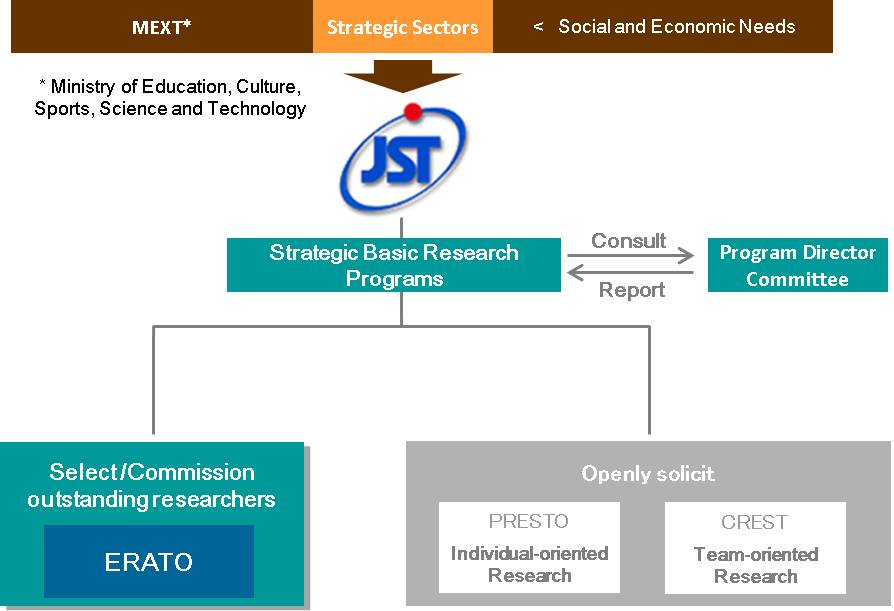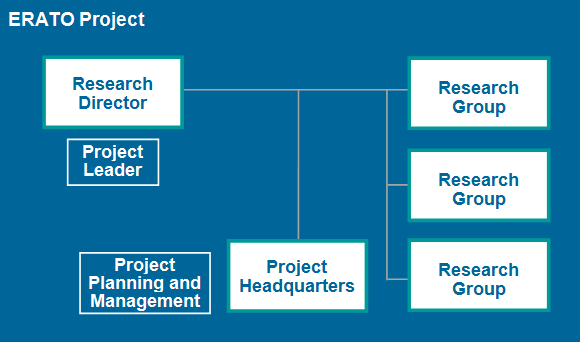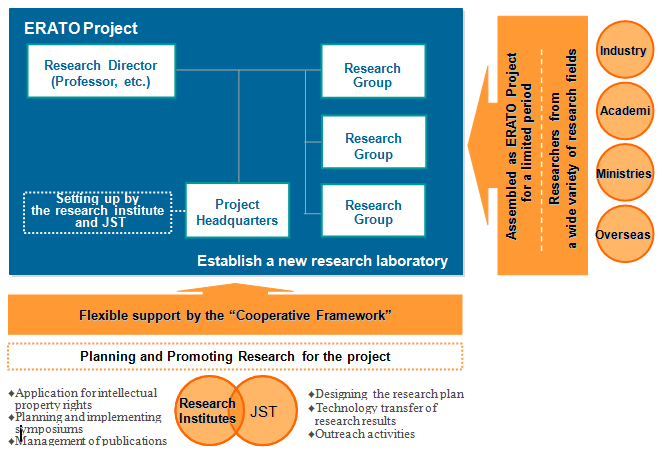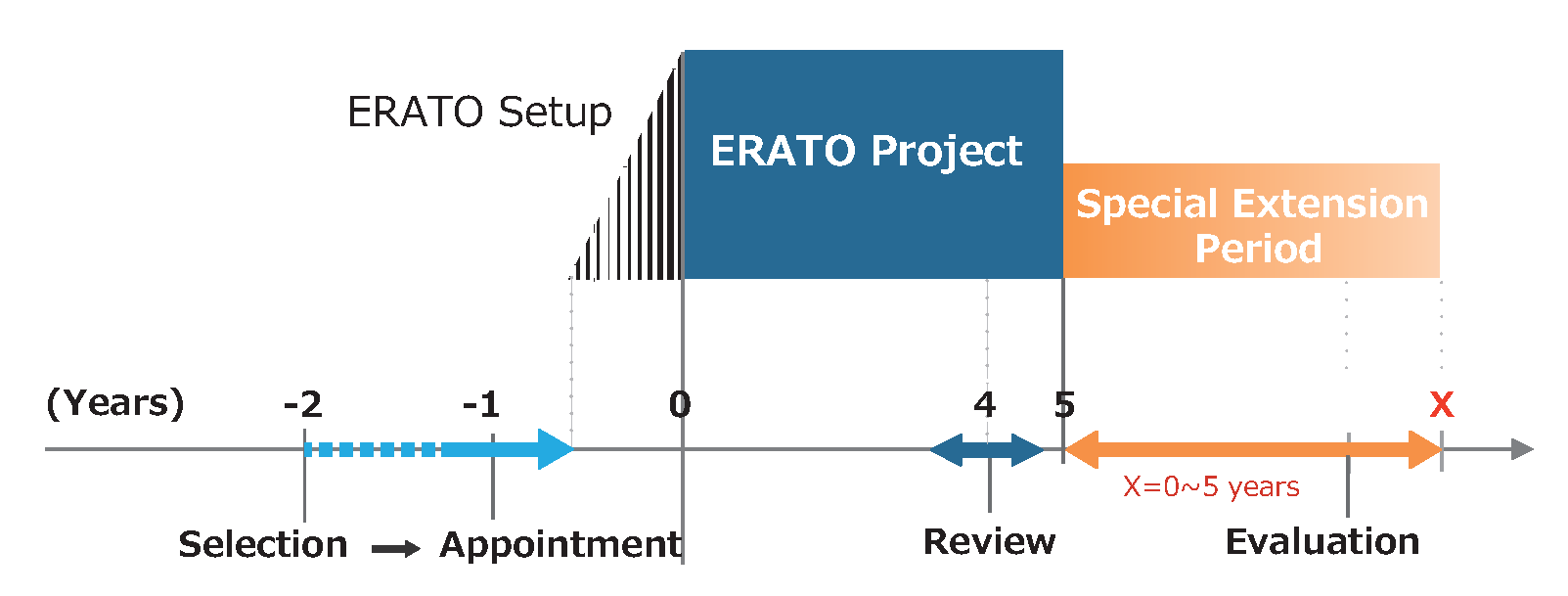- JST Home
- /
- Strategic Basic Research Programs
- /
 ERATO
ERATO- /
- About The Program
About The Program
What is ERATO?
ERATO History
The Exploratory Research for Advanced Technology (ERATO) research funding program was founded in 1981, to promote basic research in science and technology. Its mission was to make Japan a world leader in science and technology: bringing a brighter future for Japan as well as making significant contributions to the international community.
In 2002, influenced by the government’s "Second-stage Basic Plan (Master Plan) for Science and Technology" (2001-2006) and by the strategies set up by the Council for Science and Technology Policy (CSTP), ERATO received a complete makeover, under the bigger umbrella of "Strategic Basic Research Programs" initiated by the government.
The goal of Strategic Basic Research Programs is to promote problem-solving oriented basic research, guided by strategies set by the government based on social and economic needs as well as the national policy on science and technology.
In the ERATO program, for the purpose of achieving national strategic sectors, JST establishes key research areas that offer high potential for creating seeds for new technologies, then appoints a research director (from academia or industry) to be responsible for each of these strategic research areas. The research director’s job is to draw up a detailed plan for the research, recruit researchers, and direct and manage the research which may also be performed in smaller sub-groups, to achieve his or her vision as well as national strategy.
The ERATO funding program has received high acclaim both from within Japan as well as from overseas. With its 30-year contribution to the research community and to the nation, it has earned recognition among researchers as one of the most prestigious research funds in Japan. Still maintaining its original vision from when it was established in 1981, the program will continue to promote creative and challenging research projects.

Where does "ERATO" come from?
Erato was the Greek Goddess of romantic poetry. ERATO is also a near- acronym for "Exploratory Research for Advanced Technology." When the major change in basic research strategy was incorporated in 2002, ERATO had already earned recognition as one of the most prestigious research funds in the research community, and the decision was made to continue to use the name ERATO, although the fund's management and administration have changed direction since its founding.
ERATO Program Outline
Purpose
The purpose of ERATO is to form a headstream of science and technology, and ultimately contribute to science, technology, and innovation that will change society and the economy in the future.
Overview
The significant features of ERATO are as follows:
- ・ERATO promotes novel, unique, and transformative research which could change the direction of thought in a discipline or make a substantial discovery to break new ground in science and technology within the next 10-15 years.
- ・ERATO should never be an expansion of on-going research and its ultimate goal is to lead to innovative changes in industries and societies.
- ・ ERATO projects recruit best-in-class researchers from various fields beyond organizational boundaries to encourage interdisciplinary research.
- ・If necessary, Research Directors may implement a part of ERATO projects at overseas institutes for international research collaboration.
Role of the Research Director
・The Research Director acts as a project manager to draw up a detailed plan for the research, recruit researchers, and direct and manage the research groups to achieve his or her vision.
・The Research Director brings together best-in-class researchers from various fields beyond organizational boundaries to encourage interdisciplinary research.
・The Research Director is expected to collaborate, as needed, with others in CREST, PRESTO, and ACT-I research areas, in order to achieve the Strategic Objectives set by MEXT.
Researchers
The best researchers from academic, industry, and government sectors, including those from overseas, are recruited for each project.
Research Management
Each project is managed by a Research Director as a project manager, and both JST as well as the research institution to which a Research Director belongs get involved in day-to-day management of research operations. This is a unique collaboration style between JST and a research institution.
Organization
In order to drive the research project efficiently, researchers and research administrators work at a research site together with the research director. The project team consists of several research groups and the project-headquarter office for the research administration work.

Research Facility
ERATO research facilities are secured independently from existing facilities used by researchers for other projects.
Research Period and Budget
・The research period is approximately five (5) years.
・Funding amount is up to JPY 1.2 Billion for each project.
Other Conditions
The Research Director must be affiliated with a domestic Japanese research institution, where the Research Director will organize and pursue the proposed research. (Nationality will not be considered.)
ERATO Features
Virtual Research Institute – Flexible and Functional Organization
In the ERATO program, in order to tackle a creative and challenging research project, "a Virtual Research Institute" is organized under the leadership of a research director, and collaboratively managed by JST and a research institution. This "JST-Institution Collaboration Framework" is uniquely established recently for the ERATO program and is different from typical contract based research.
In this collaboration framework, the research institution carries out the actual research tasks as well as research administration tasks. JST, on the other hand, gets involved in overall project planning, project bring up operations and on-going project management.
The following five points are features of the ERATO program. The first three are uniquely related to the "Collaboration Framework."
- JST commissions a research director for each project accepted by JST as a ERATO project. The director will be responsible to manage the entire research as a staff of JST (while maintaining his/her position in the institution where they are also employed).
- The research director establishes a new research facility independent from the existing ones.
- Besides research groups with researchers, the project-headquarter (HQ) office is setup with research administrators for project planning, administration, and project management work.
- Recruit best-in-class researchers from various fields, to encourage interdisciplinary research.
- The group forms a Virtual Research Institute which is temporal and will be dissolved at the end of the research project.

Making the most of research period
In order to best utilize the unique features of ERATO program and maximize the breakthrough discoveries and innovations from each project, as a trial, the program is currently allowing up to one year for a project bring-up work before the official start of the project, and for those exceptional projects, additional year(s) of grant will be provided.

The bring-up period
In the ERATO program, each new project will start with new research facilities, new team of researchers, and new organization. Getting the new team, facilities, and organization require some time, effort and money. We allow up to one year of bring-up period (typically a half year), as a trial, so that when the project starts officially, they can run at full speed from the beginning.
The special extension period
After completing five years of the research, some projects may have outstanding outcomes and be considered worth providing an extra grant to further pursue the research work. The extra grant can be provided for a year in principle, up to five additional years. The purpose of this extension period is to pursue the opportunity to become the world leader in the new and exciting given field, leading to the deployment of new discoveries and accomplishments to other researchers and engineers.

















